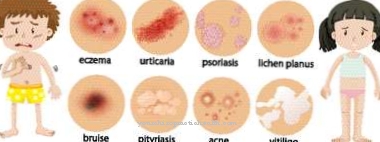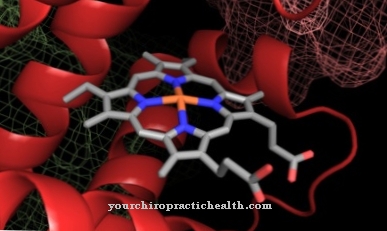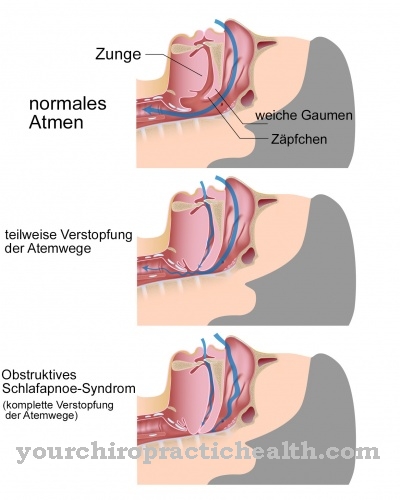What is Goldenhar Syndrome?

© Artemida-psy - stock.adobe.com
Goldenhar syndrome is a congenital malformation that belongs to the branchial arch syndromes and is estimated to affect one in 3,000 to 5,000 newborns. It leads to deformities in the face, most of which affect one half of the face. These range from auricular dysplasia to complexes of malformations in the eye and ear area, in the face, jaw and vertebral bodies. The kidneys and heart can also be affected.
causes
The causes of Goldenhar Syndrome are unclear and research into it is ongoing. The extent to which the causes are genetic has not yet been clarified. Most cases are sporadic, one to two percent within a family. So far, no abnormalities have been detected in the DNA. The malformation in the uterus is likely caused by an interruption in the blood supply or by bleeding that occurs in the tissues.
This leads to combined developmental disorders in the first and second gill arches, in the gill furrows and in the temporal bone. The fourth to eighth week of pregnancy is assumed to be the time. The severity of the Goldenhar symptom depends on both the timing and the severity of the damage. Harmful substances such as drugs, certain drugs or insecticides / herbicides are suspected to be the cause.
But fetal alcohol syndrome, gestational diabetes or hormonal disorders are also suspected of promoting the onset of the disease. It is also possible that hematomas in the area of the gill arches are responsible for the damage. The causes of the hematomas are different. Possible factors include increased pressure in the blood vessels, insufficient supply of oxygen or drugs that increase blood pressure.
Symptoms, ailments & signs
The manifestations of the Goldenhar syndrome are very different. Not every symptom has to be present and the symptoms are different for each person affected. The majority of those affected by Goldenhar syndrome have unilateral facial asymmetry and auricular malformation. Your lower jaw is shortened on one side of your face, and your chin is shifted towards the diseased side. The affected corner of the mouth is higher and the cheekbone is underdeveloped. The chin is receding.
Another symptom is an epibulbar dermoid, a benign tumor on the lower eyelid, and / or a lipodermoid, a conjunctival tumor. Many sufferers have preauricular appendages, appendages in front of the auricle, consisting of skin, cartilage or connective tissue. Often the mouth gap is excessively wide on one side (macrostomy). The spine is also affected by Goldenhar syndrome. Malformations often occur in the upper spine area and in the cervical vertebrae.
Further symptoms can be a cleft palate, lip or tongue, a tongue that is smaller on one side, tooth anomalies, kidney anomalies and ankyloses (joint stiffness). There are also hearing problems or disorders that can impair linguistic and intellectual development. In about 15 percent of the cases there is an intellectual disability. Two-thirds of patients with Goldenhar syndrome are male. The right half of the body is affected more often than the left. In some Goldenhar patients (up to 33 percent), the symptom occurs on both sides of the body.
Diagnosis & course
The diagnosis of Goldenhar syndrome is made clinically by paediatricians together with a specialist in clinical genetics or human genetics. None of the individual symptoms are indispensable for the diagnosis. During diagnosis, the symptoms are differentiated from those of Treacher-Collins syndrome (dystosis mandibulofacialis) and those of Wildervanck syndrome, among other things.
As a rule, the extent of the hearing impairment - from mild hearing loss to one-sided deafness - is diagnosed within the first six months of life. Most children born with Goldenhar Syndrome have a normal life expectancy.
Complications
Goldenhar syndrome leads to a number of different malformations, most of which occur on the face. As a rule, there is an asymmetry in the face, which is present in almost all patients. In addition, there is also a malformation of the auricle, which can lead to impairment of hearing. It is not uncommon for Goldenhar syndrome to develop a benign tumor in the area of the eyes.
A cleft palate appears and malformations of the teeth occur in the oral cavity. These can lead to severe pain. Furthermore, the syndrome leads to mental complaints and disabilities, so that many patients are dependent on the help of other people in everyday life. If the patient still does not suffer from other ailments or illnesses, there will be no reduced life expectancy.
A causal treatment of Goldenhar syndrome is not possible, which is why only the symptoms can be limited. This is mostly done with the help of surgical interventions or therapies, whereby there are no further complications.
When should you go to the doctor?
If the expectant mother notices circulatory disorders during pregnancy, she should consult a doctor. If the pregnant woman is bleeding or has the feeling that areas of the body are not being supplied with sufficient blood, a doctor's visit is required. The preventive examinations offered during pregnancy should generally be fully attended to. During the controls, irregularities, development delays or anomalies in the unborn child can be detected at an early stage thanks to the sophisticated technical possibilities.
It is generally advisable for the pregnant woman to consult a doctor as soon as she has the feeling that something may be wrong. In the case of an inpatient stay, an extensive examination of the newborn is initiated immediately after delivery. Nurses and maternity doctors check the baby's health. The malformation is diagnosed so that parents and relatives do not have to take any further measures.
If a home birth takes place, a midwife takes over the first check-ups of the baby. It also takes further measures independently when the visual changes in the face make visual contact. If an unexpected and sudden birth occurs without a medical nurse, mother and child should consult a doctor immediately after the birth. It is advisable to call an ambulance so that a medical check-up and treatment can take place as soon as possible.
Doctors & therapists in your area
Treatment & Therapy
The malformations in Goldenhar syndrome are treated surgically. Both body function and appearance are included in the treatment. From around the age of three, the malformation of the jaw often narrows the airways, making reconstructive surgery necessary. The jaw is reconstructed from a rib or by stretching the bone. Tooth misalignments are corrected by the orthodontist.
Pre-auricular appendages and larger dermoids are removed. Plastic surgery corrects the zygomatic bone and the forward displacement of the lower jaw. The corners of the mouth are corrected and the soft tissues of the cheek on the affected half of the face are built up through autologous fat transplantation. In addition, the ear can be reconstructed and the eyes can be treated, depending on the findings. Speech therapy is used if Goldenhar syndrome is associated with deafness.
Hearing tests are carried out at an early age and hearing aids are given if necessary. If heart defects occur, treatment is also necessary here. Children with Goldenhar syndrome are also affected internally by the external malformation. As a result of injuries and the awareness of the deformity, psychological impairments arise in the form of reactive disorders. Psychological support is therefore part of the treatment and helps to cope with the psychosocial stress.
Necessary operations add to pain experiences that are accompanied psychologically. A psychologist also ensures that children who are about to have an operation develop realistic expectations of the results. Parents also receive psychological support. Children whose mental development is affected need rehabilitation measures early on. These stimulate their mental development and include continuous care and treatment.
Outlook & forecast
The prognosis for Goldenhar syndrome is poor, although there are various treatment options and in most cases the disease does not result in sudden death of the newborn. The congenital disorder is characterized by malformations of the face and the vertebrae.
These occur individually and show up in a different intensity in each patient. The malformations can be corrected with the help of surgical interventions. The focus is on restoring functionality so that the jaw, throat and throat do not lead to any life-impairing consequences.
Despite all current medical options, scars and irregularities in the optics remain after an operation. In some patients, multiple interventions have to be performed to optimize physical functions. This can lead to mental disorders. The Goldenhar syndrome thus carries the risk of secondary diseases. A complete regeneration of the malformation is only given in exceptional cases. Rather, additional organ damage to the kidneys or heart is to be expected.
If left untreated, these can lead to sudden death. In addition, patients often suffer from impaired hearing. This is determined and diagnosed within the first year of life. Since it is not possible to restore the natural hearing ability, hearing aids can normally be used to correct the hearing ability adequately.
prevention
There are no guidelines that suggest possible prevention of Goldenhar Syndrome. Whether it is possible to prevent the syndrome depends on clarifying the actual causes. So far, however, there are no recommendations in this regard.
Aftercare
The options for aftercare are relatively limited in Goldenhar syndrome. It is a congenital disease that cannot be treated causally but only symptomatically.The affected person is dependent on lifelong therapy to alleviate the symptoms and avoid further complications.
Since the further course of the Goldenhar syndrome depends strongly on its severity, no general prognosis can be given. The individual misalignments and malformations of Goldenhar syndrome are usually treated with the help of surgical interventions. Those affected should rest after such an operation and take care of their bodies.
Exhausting activities or sporting activities should be avoided, and stress should also be avoided. Speech problems can be treated with speech therapy in Goldenhar syndrome. The various exercises can also be carried out at home in order to speed up the treatment.
In many cases, however, those affected are also dependent on psychological treatment. The support from friends and family makes a lot of sense. Contact with other patients with Goldenhar syndrome can also be useful, as this leads to an exchange of information.
You can do that yourself
First and foremost, those affected by Goldenhar Syndrome need loving and caring treatment as they suffer from serious psychological complaints and an intellectual disability. As a rule, the help of parents and relatives is necessary in order to provide the patient with appropriate care.
Since in many cases those affected also suffer from inferiority complexes or from reduced self-esteem, facial malformations should be treated. Discussions with other sufferers of Goldenhar Syndrome also help to exchange information. Furthermore, speech therapy can have a very positive effect on the course of the disease and alleviate possible speech problems. The person concerned can also do various language exercises at home.
Children need special reassurance from the doctor and their parents before surgery. However, the results should also be realistically clarified in order to avoid later disappointments and associated psychological complaints. Mental development can also be increased through permanent support in order to avoid complications in adulthood. As a rule, the patient's life expectancy is not negatively affected by Goldenhar syndrome.












.jpg)



.jpg)










.jpg)
